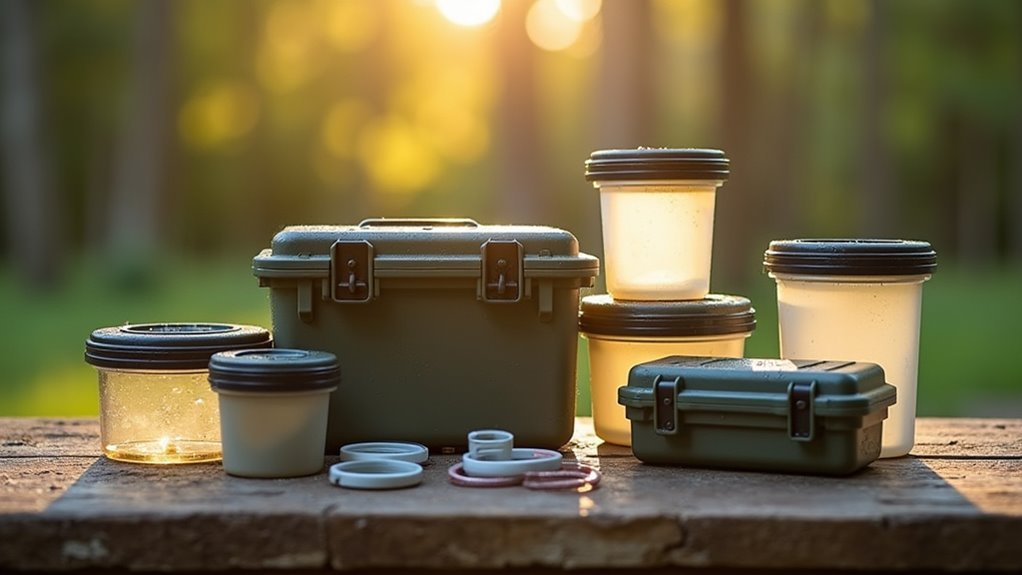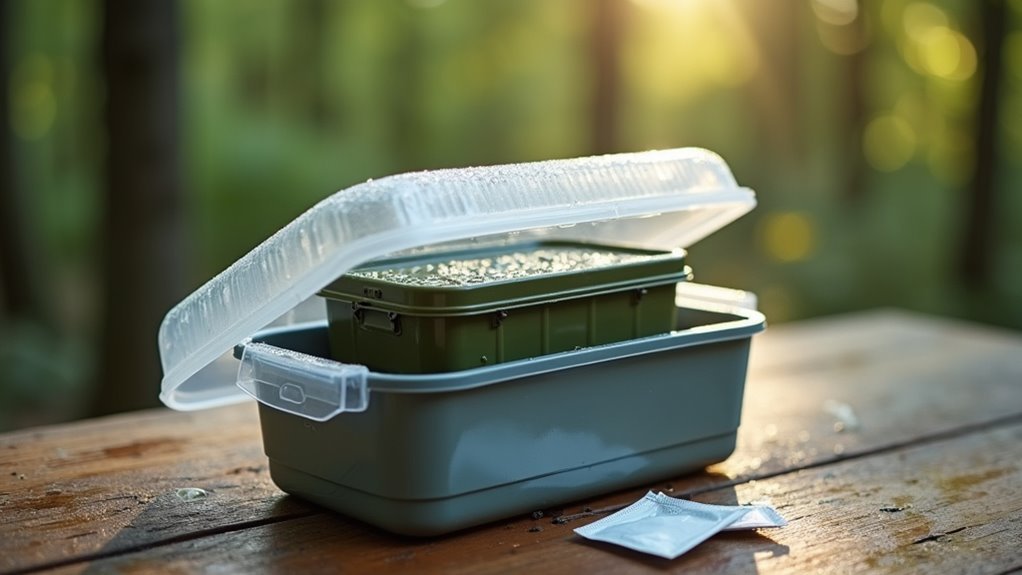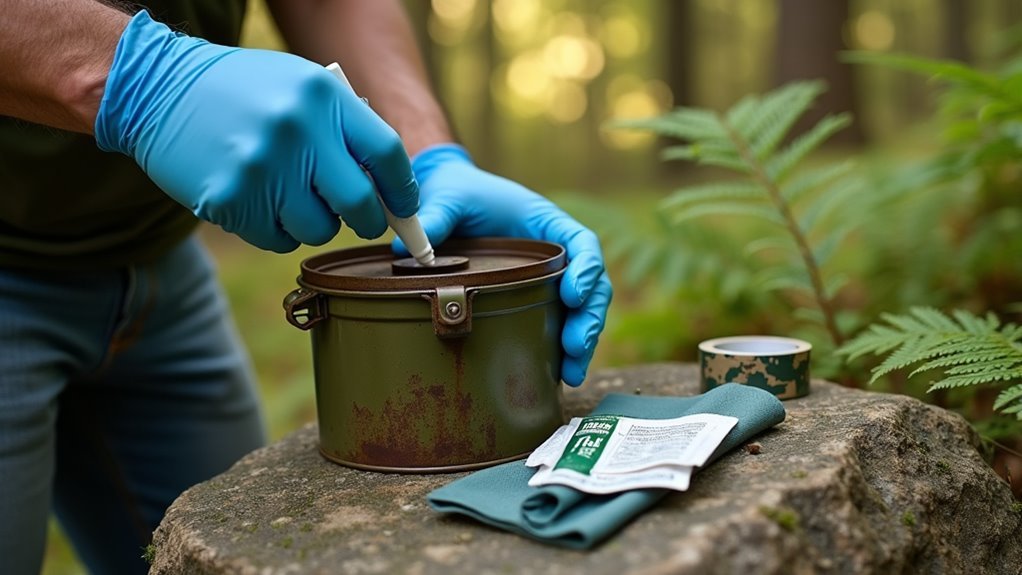Some of the links in this article may be affiliate links. If you make a purchase through these links, we may earn a small commission at no extra cost to you. Thank you.
I’ve been creating geocaches for over a decade, and let me tell you, nothing’s more disappointing than finding your container filled with water. I’ve made this mistake myself—once placed a regular plastic container that ended up as a soggy mess after just one rainstorm. Now I’m careful to use proper waterproof solutions like ammo cans or quality Lock & Lock containers. Want to know how your caches can survive even the harshest elements?
Selecting Durable Waterproof Containers for Long-Term Protection

The most frustrating thing that can happen to your geocache is water damage.
I’ve seen too many logs turn to mush when cache containers fail to keep the elements out.
In my experience, ammunition boxes are absolute workhorses—they’re practically bombproof for around $10 at surplus stores.
Ammo boxes laugh at the rain when other containers surrender. They’re the true champions of geocache protection.
Lock & Lock containers are my personal favorites; those four-side locking mechanisms create a seal that water just can’t penetrate.
And don’t overlook Rubbermaid containers—they’re reliable and come in so many sizes.
For smaller caches, I’ve had great success with the Outus Waterproof Cases.
They’re perfect for logs and small swag.
Wait, actually—I should mention pill bottles too!
If you nest them inside one another, you’ll get double the protection.
Your geocachers will thank you!
Strategic Placement to Maximize Container Lifespan
While selecting the right container is essential, where you hide it can make or break your cache’s survival chances.
I’ve found that placing containers under natural overhangs or in dense foliage dramatically extends their lifespan.
In my experience, even the toughest ammo can will deteriorate quickly if it’s constantly soaked by rain or baked in direct sunlight.
That’s why I always look for spots with natural protection—maybe a rock formation that shields from above, or a hollow in a tree trunk that stays relatively dry.
Think of your container like, well, like a house—it needs a good roof!
I’d prioritize locations that minimize exposure to moisture and UV rays.
Trust me, a strategically placed cache in a protected spot will outlast an exposed one every time.
Double-Container Methods for Enhanced Moisture Resistance

Double-container protection has become my go-to strategy for keeping geocache contents bone-dry, even in the soggiest conditions.
I’ve found that nesting a smaller container inside the primary one creates an extra defense layer that’s remarkably effective.
Layering containers provides foolproof protection, turning simple nesting into a moisture-defeating fortress for your geocache contents.
By placing my logbook in a smaller pill bottle, then tucking that inside a larger outer container, I’m basically giving my cache two chances to repel moisture.
This technique works brilliantly in rainy environments where single containers often fail. From my experience, those extra few millimeters of protection make all the difference!
- A tiny pill bottle nestled snugly inside a larger one, like a treasure within a treasure
- A delicate logbook cocooned in multiple layers, safe from the pelting rain outside
- Clear containers revealing the smaller one inside, like a ship in a bottle
Regional Weather Considerations for Container Selection
Because your environment directly impacts your geocache’s longevity, choosing the right container for your specific region isn’t just helpful—it’s essential.
In my experience, coastal areas demand plastic containers since salt air basically eats through cheap metal ones.
I’ve seen perfectly good ammo cans turn to rust heaps within months!
For those freezing environments, watertight ammo cans or quality plastic works best—they can handle the temperature swings that cheaper containers just can’t.
Living in a rainy region? You’ll definitely want airtight solutions.
Don’t rely solely on silica packets; they tend to, well, explode when wet (learned that the hard way!).
Even if you’ve found a sheltered spot, consider how your region’s specific challenges—wind, freeze-thaw cycles, precipitation—might affect your container choice.
Lock-n-lock containers or bison tubes might be worth the extra investment.
Maintenance Practices to Preserve Cache Integrity

How often do you actually check on your geocaches after placing them?
I’ve learned the hard way that regular maintenance visits aren’t just helpful—they’re essential for keeping your cache waterproof and functional.
Even containers that seem indestructible need inspection every few months, especially in harsh environments.
You want a cache big enough to accommodate your contents while still allowing room to check seals and corners for potential leaks.
- Gently running your fingers along container edges feeling for cracks that might let moisture seep through
- Carefully examining rubber O-rings and gaskets for signs of wear, replacing them before they fail completely
- Testing latches and locks by closing them with a piece of paper inside—if it slides out, water can get in
Frequently Asked Questions
What Is the Best Way to Waterproof a Shipping Container?
I’d apply high-quality marine coatings to the exterior, seal all joints carefully, and secure proper ventilation to prevent condensation. Don’t forget to maintain these waterproofing elements regularly for lasting protection.
What to Put in a Geocache Container?
You’d think I’d say fancy items, but I’ll keep it simple. My item suggestions: folded logbook, small pencil (pens freeze!), trade trinkets, and for larger caches, a waterproof secondary container.
What Not to Put in a Geocache?
I’d never include banned items like food, alcohol, weapons, medications, or anything illegal in my geocache. Also avoid fragile containers, silica packets, pens (use pencils), and plastic baggies.
How to Properly Maintain a Geocache?
Like clockwork, I check my geocache every 1-2 months. I verify waterproofing, replace soggy logbooks, confirm site selection remains ideal, and keep containers clean. Thorough inspections prevent deterioration over time.